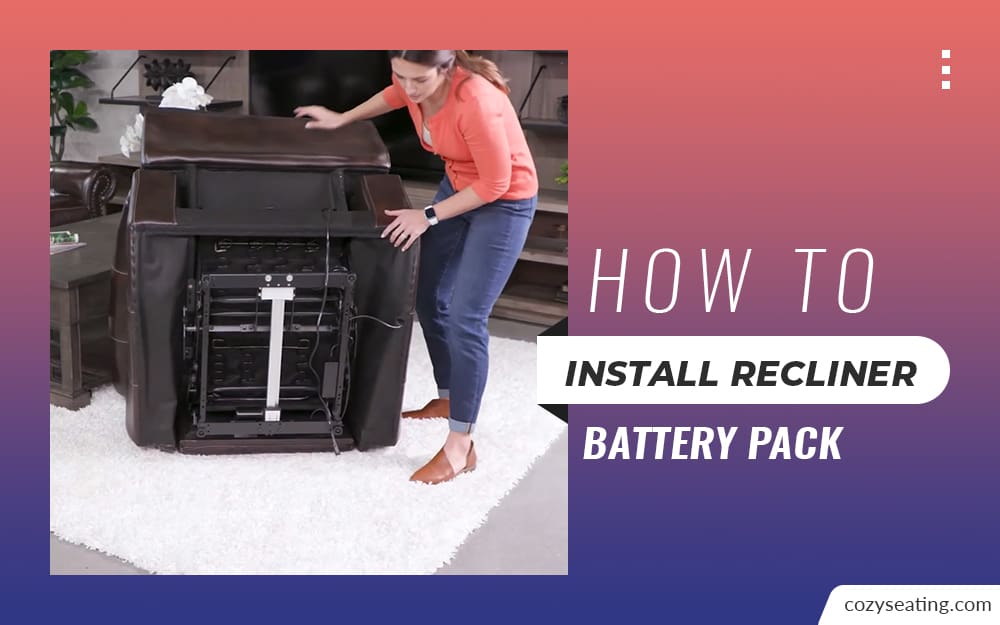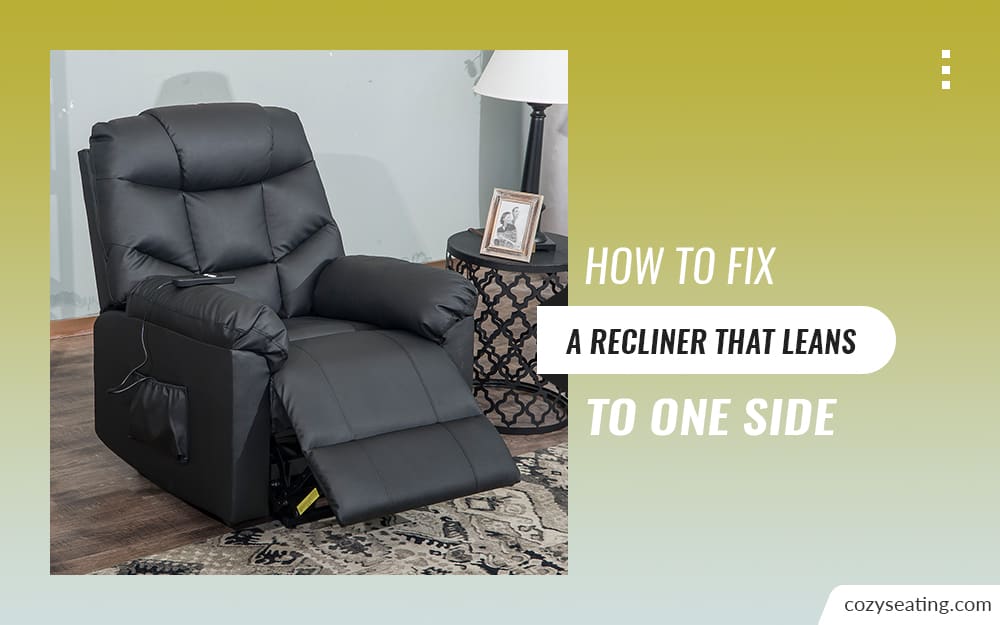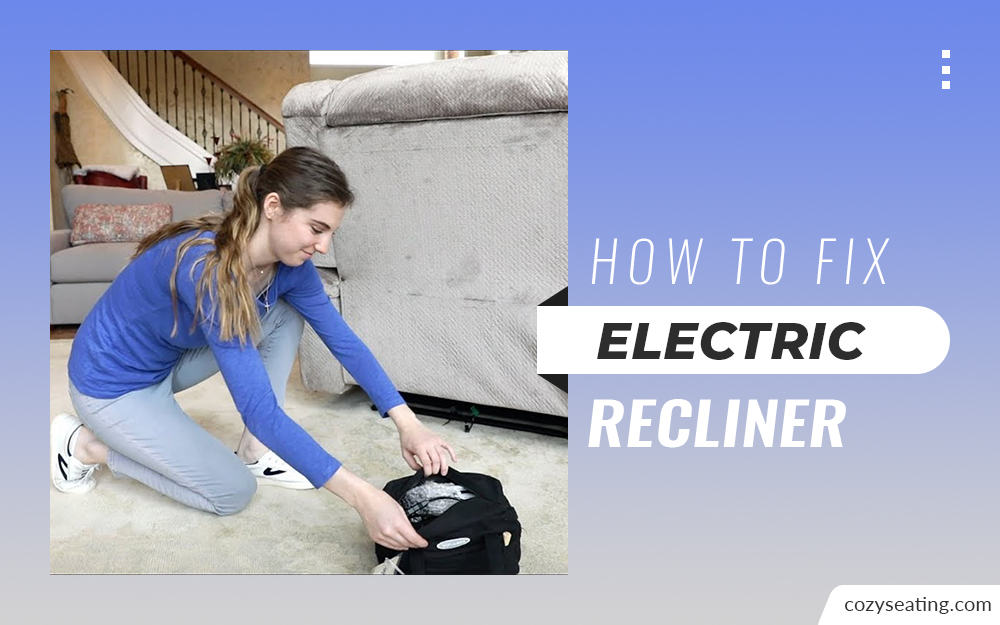
Disclosure: This site is reader-supported & contains affiliate links. We may earn a commission through products purchased using links on this page. Learn more

Your sweet recliner suddenly starts to be lopsided/ lean on one side. That happens after an extended period of comfort and relaxation the chair has been offering you. Hence, you can’t put up with the nuisance, and you need to fix the problem right away.
Luckily, bringing your recliner “back to life” isn’t a hard nut to crack. So, how to fix a recliner that leans to one side?
You can fix your lopsided recliner in two different ways, depending on the cause of its leaning. If the leaning is due to its cushions/padding wearing out, add another layer on top. Where the cause of the problem is a loose or unscrewed nut, just fasten it, and your recliner will be as good as new.
Keep reading to explore how to fix your lopsided recliner and other essential details of this noble task.
Table of Contents
What Are The Causes Of Your Recliner Leaning To One Side?
There’re several causes of your recliner leaning to one side. Once you figure out the genesis of the lop-sidedness, it becomes easy to fix. Here we go.
- Broken/ Weak Mechanism
- Uneven Floor
- Uneven Padding
- Poor Frame Construction
- Loose/ Missing Screws
Below is an explanation of each of these causes. Read through.
1. Broken/ Weak Mechanism
A broken reclining mechanism is the most direct cause of your lopsided recliner. Your recliner chair has a sliding frame that allows its front and forth reclining. If any part of the frame faults or breaks down, your chair leans to one side.
2. Uneven Floor
Unequal weight distribution can cause lop-sidedness. How? When one side of your recliner chair’s base is more elevated, the lower side carries more weight that causes stress. Although replacing the parts is an option, moving to an even place is the ideal remedy.
3. Uneven Padding
Unequally distributed recliner cushions create a picture of a leaning chair. That needs no structural repair but a simple rearrangement of the padding. Alternatively, you could consider adding more pillows on the leaning side.
4. Poor Frame Construction
You can quickly notice a poorly built frame of your recliner immediately you sit in it. The problem is common with low-quality models made of cheaper materials. Since the warranty is still valid, you can go for a replacement. If the needed repair is minor, you can quickly fix it.
I’d recommend a heavy-duty recliner for more robust frame construction if you can afford it.
5. Loose/ Missing Screws
If the screws of one side of your recliner are loose, your chair may lean towards that side. Similarly, if some of your recliner’s screws are missing, its structure may collapse on that area leading to its leaning.
What Do You Need To Fix Your Leaning Recliner Chair?
You need a few necessary tools to fix your leaning recliner chair. These essentials include the following:
- Screwdriver– it’s an easy-to-find and multipurpose tool in many homes. It comes in various sizes and heads to unlock fastened joints and panels.
- Oil- the oil serves as a lubricator for old, creaky, and rusted joints and nuts for their smooth removal. You can either apply or spray the oil.
- Newspaper– you need some old newspapers to prevent oil spillage on your working surface.
- Wood glue– its strong adhesive sticks object together in a construction setting. It rejoins stiffening wood joints and broken wood panels. Apply it evenly for ideal results.
- Pry bar– it’s a thick metal rod, flat on one side while the other is curve-shaped. Its design allows it to force many unbolted parts to open. Nevertheless, you need to be extra careful not to harm your recliner in the process. Be sure the penal can open before applying the force.
How To Fix A Recliner That Leans To One Side?
You can fix a recliner that leans to one side by following the steps outlined below. You’ll do so efficiently and within a short time. Let’s get started.
Step 1: Lay your recline in a suitable posture making its underside visible. Unfasten the screws on the wooden panel and perhaps on the footrest, depending on the affected area. Secure your screws for post-repair use!
Step 2: Remove any padding textile (upholstery) covering hiding the frame for a clear view of the damaged area.
Step 3: spray or apply oil on creaky and rusty springs and joints for lubrication. Remember to place newspapers or a towel on your working space to catch dripping oil and wipe the excess one.
Step 4: Fasten any loose or missing joints using your screwdriver. Be keen not to unfasten the joints near the springs. That would cause them to release tension from the coils and spring up.
Step 5: Identify any hairline or big cracks around the recliner frame or joints. If any, there’s a need to replace them promptly.
Step 6: Clean out all areas where you remove any part of your recliner for replacement. Get guidance from the recliner’s or new parts’ manual during installation.
Step 7: Use wood glue to fix any broken or disconnected wooden parts. Also, you could consider providing extra support by installing metal bracing. Even so, if the damage is intense, I’d recommend you replace the part with a new one.
Step 8: Ensure that all parts are functional and tightly placed, cover the mechanisms with the wooden panels, and put back the padding textile covering.
What Are The Do’s And Don’ts When Fixing A Lopsided Recliner?
There are several Dos and Don’ts when fixing a lopsided recliner. Let’s have a look at each category.
DOs
This category includes what you need to do when fixing your recliner chair.
- Always turn your recliner upside down when fixing its mechanism to give the footrest enough grip.
- Avoid guesswork by getting assistance from your recliner’s manual.
- If the small parts are the root of the problem, replace them with new ones. They’re very much affordable!
- Carefully tighten all the nuts and screws as they’re the primary source of your recliner’s support.
- Always keep your recliner chair in an elevated posture when not in use. That keeps it off stress, and as a result, your chair attains a greater lifespan.
- Spray or apply oil on rusty or creaky nuts and joints for easier unfastening and replacement.
- Seek help from others to allow faster and safer working. That way, you can easily move your recliner as needed without fear of more breakages.
- Maintain regular checkups of your recliner’s frame and structure. I’d recommend a monthly examination.
- Buy quality recliners from recognized manufacturers. Cheap ones may be expensive in the long run due to frequent repairs.
Don’ts
Likewise, there’re some things you need to avoid when fixing your leaning recliner. They’re harmful to your chair and include the following.
- Don’t flip over a heavy recliner by yourself. Heavy drops may cause damage to the footrest.
- Avoid using old, rusty screws and nuts for repair or replacement purposes. The worn-out parts can be fatal because of their inability to withstand pressure when sitting in the chair.
- Don’t be reckless when working with the frame, as it has several things that can hurt you.
- Avoid using your bare hands to apply the glue; use a spoon instead. Some skins are allergic to glue and may react with it.
- Don’t allow kids to play carelessly with the recliner; neither should you.
When Should You Seek Professional Help In Fixing Your Leaning Recliner
You should seek professional help in fixing your leaning recliner when the problem is too extreme for you to fix. At this point, you have tried everything in your capability but yield no fruits. Here are a few lookout points as to when you can call an expert.
- When there’s substantial damage to your recliner’s frame and the mechanism failures ultimately
- When you can’t identify the cause of the leaning, you have also searched the internet and can’t get any hint.
- When you can’t move around to inspect your recliner because you’re physically challenged
- After replacing a part, causing more severe damage than the initial one
FAQ
Can I fix A Broken Recliner?
Yes, you can fix a broken recliner. The repair process of your recliner is very straightforward and less time-consuming. It involves replacing the missing or damaged fasteners (nuts and screws) and reinforcing or rebuilding a broken wooden frame.
How Do You Stop A Swiveling Recliner?
You can stop a swiveling (turning around) recliner by putting a tinny wedged rubber between the chair’s swiveling pole and its base. Hammer the wedge tenderly into the base to create a seal. Avoid hard hammering as it may hurt your recliner chair. The wedge builds friction limiting the rotation of your swivel chair.
Is There A Way To Lock A Recliner?
Yes, there is a way you can lock your recliner. Hold the armrests and put your feet on the lower crossbar when your chair is upright. Push outwards with your legs while leaning back slowly. Lock your recliner in place once you get to your desired position.
How Do You Keep The Recliner Reclined?
You can keep your recliner reclined by increasing the reclining tension. For that reason, move the wing nuts or thumb wheels clockwise. The basic instructions are similar in both cases because their adjustment happens the same way when increasing or decreasing recliner tension.
Why Does My Recliner Not Recline?
Your recliner doesn’t recline because the lever on its side is loose. Check out for a missing nut on the lever’s exterior where it connects with the chair. If you can’t trace the nut, use a ratchet or socket to screw the arm tightly.
Bottom Line
Our long journey of fixing a lopsided recliner has come to an end. So far, so good, and the ball is now in your courts! I’m sure the exercise is a non-issue for you moving forward.
This article points out the possible causes for easy problem identification. It also lists the must-have tools for every recliner owner. Most important is the step-to-step guide on how you can repair your recliner that leans on one side.
Therefore, you have no reason to bear with the annoyance of a leaning chair. Put all that into action and thank me later!
Recommended Reading

How To Install Recliner Battery Pack
This article is for you if you’re wondering how to install recliner battery pack on your furniture or if you want to replace the old battery pack.

Recliner Vs. Gaming Chair
Welcome to our definitive guide on recliner vs. gaming chair. What differentiates the two comfy chairs? How do you pick an ideal recliner or a gaming chair?

How To Clean Microfiber Recliner (Pro Guide)
Get a bang for your buck by learning how to clean microfiber recliner. It’s easy, quick and quite affordable. Enter to read our pro guide.

How to Fix Electric Recliner: DIY Today!
The electric recliners are easy to maintain. But, they develop problems over time if not well taken care of. The article discusses how to fix electric recliner.
